Dealing with crises and catastrophes afield.
By Jerry Thoms
"What an idiot!" was the non-verbal message on my vet's face as he looked at me after he examined the three-inch long, red, raw gash on my German shorthair's chest. And I felt like a fool for not better bandaging and more quickly bringing in the dog for the stitches necessary to close the ugly, open wound in his hide.
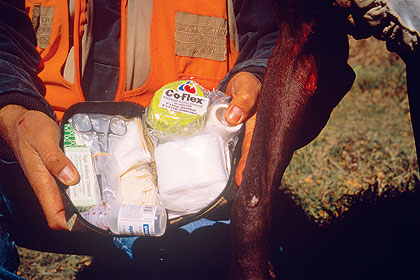 A skin cut is one of the most common injuries for gun dogs in a training session or on a hunting trip. Though any laceration that slices open a dog's epidermis is serious, not all such wounds might require an immediate trip to a veterinarian. This particular cut, on the front leg of a seven-year-old German shorthair pointer, was bandaged by the dog's owner in the field according to instructions given in books and videos. |
My make-shift bandage, composed of several "for-people-use" band-aids, a handful of Kleenex, and half a roll of black electrical tape to hold everything in place, hadn't held up with any real effectiveness. The laceration was now particularly irritated and nasty looking, though the dog never showed any signs of discomfort in the hour that I hunted with him after I noticed and clumsily tried to seal up and protect the laceration.
Seven long days of kennel rest--in the first week of pheasant season--went by before my German shorthair was ready to safely hunt again. Had I done a better job of treating his wound when I first noticed it, then brought the dog to the vet a lot sooner for stitches, the convalescent period would have been much shorter, according to my veterinarian. Plus, I wouldn't have looked like an idiot.
More than 35 years ago, ignorance was a big part of my excuse for this botched effort to deliver first aid to my gun dog. Back then I just didn't know how to properly treat the injury, nor did I understand what medical gear was necessary to fix the canine medical emergency I had encountered.
Today, there is no good reason for any gun dog owner to mess up an in-the-field medical problem while hunting, training or exercising any dog because there is plenty of clear, concise, easily accessible and authoritative information on the subject. And there are some standard kits, homemade or commercially available, designed to take care of canine medical emergencies ranging from minor crises to major catastrophes.
Books and Videos
If you need to know more about treating canine medical problems and emergencies in the field or want to assemble or buy a dog first aid kit, just look in the table of contents and the index of A Field Guide to Dog First Aid by Dr. Randy Acker or The Orvis Field Guide To First Aid For Sporting Dogs. Or watch two short videos: one titled Advanced Canine First Aid For Sporting /Outdoor Dogs by Dr. Randy Acker; the other titled Field First Aid For Your Gun Dog featuring Dr. Tom Holcomb and Bob West.
Each of these short publications and hour-long videos provides a very descriptive list of common medical problems and practical methods for treating many in-the-field-emergency situations that can afflict your gun dog. Included are: barbwire cuts (probably the most common type of laceration); abdominal wounds (punctures caused by everything from dog fights to gun shots); collapse (from heat stroke or hypothermia); fish hooks (stuck in the lips or swallowed into the stomach); bleeding (from the tongue or ear flaps, often caused by running through briars); and broken bones (legs, ribs, toes, or tails).
Add to this list insect bites, ingested poisons, eye injuries, as well as techniques for applying a tourniquet and putting a muzzle on an injured dog. Less specific but still important are topics such as administering CPR to a dog, carrying a dog with broken bones, and removing weed seeds, other plant parts, and assorted grit from the eyes, ears, and nose of a canine.
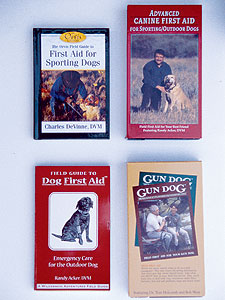 Read these books and carefully study the videos on canine first aid with the thought in mind that there will certainly someday be a "pop quiz" and maybe a "final exam" out in the field. |
If your gun dog or your hunting partner's dog hasn't experienced any of these problems, you are very lucky. But if you train, hunt, or exercise your dog on a regular basis, you can be certain that sooner or later you will become personally familiar with one or more of the subjects on this list. I know I have.
A Labrador's face full of porcupine quills, a German wirehairs' bloody feet, a springer spaniel's leg abraded and maybe broken by a leg-hold trap--these were among the ailments I've recently treated with a dog first aid kit--and not over the course of an entire hunting season but in just one weekend. Knowing what to do when faced with these problems and having the equipment to do it made the difference between success and failure in keeping these hunting dogs hunting€¦or in one case, making a crucial decision to immediately take a dog to a veterinarian.
Here's a more detailed overview of the two books and two videos and some information on readily available kits, all designed to help gun dog owners better understand and treat most medical crises and many catastrophes in the field.
The Orvis Field Guide to First-Aid For Sporting Dogs by Charles De Vinne, DVM, ($16.95 Willow Creek Press, (800) 850-9453) is a handy 130-page pocketsize book that covers a wide variety of in-the-field canine medical problems ranging from the minor to the disastrous. The emphasis is on "how to": for example, how to treat several types of lacerations, wounds, and abrasions; how to bandage chest or abdominal injuries: how to apply a splint or tourniquet; how to treat thermal or chemical burns; and how to perform CPR or to carry dogs with broken bones.
Likewise, there are specific instructions on "how to" deal with trauma-related shock, electrical shock, dehydration, nosebleeds, drowning, shotgun and bullet wounds, insect bites, and exposure to a wide variety of poisons. Also included is advice on how to take a dog's temperature, apply eye ointment, or keep a canine's mouth open while performing emergency treatments.
For quick reference, the book's index has more than 125 entries that cover such diverse topics as allergic reactions, bloody tails, convulsion, dog bites, esophageal obstructions, frostbite, giardia, mouth injuries, poisonous plants, spider bites, ticks, torn toenails, and insect stings. If it can happen to a gun dog, it's probably going to be included in this little book.
Dr. DeVinne is a "sporting dog" veterinarian, an avid wingshooter and a gun dog owner who knows what to
expect with pointers, flushers, or retrievers in the field or on the water.
Field Guide To Dog First Aid by Randy Acker, DVM, ($15.00, Wilderness Adventures Press (800) 925-3339) is another pocket book with direct instructions and emphasis on diagnosis and treatment of most common injuries and medical problems Dr. Acker has seen in the past 20 years while treating hunting dogs in his Ketchum, Idaho veterinary clinic.
Types of injuries and procedures for dealing with them include bleeding lacerations (on all parts of a dog body), fractured and dislocated bones (legs, pelvis, and back), and breathing problems (coughing and choking). Acker also considers injuries to a dog's eyes, nose, and tongue as well as damage from such things such as frostbite, porcupines, and carbon monoxide poisoning. In addition, he provides remedies for dogs after close encounters with skunks and animal traps.
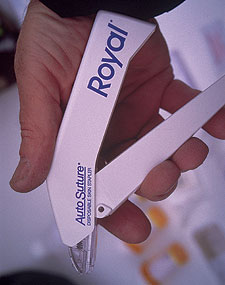 "The quickest and most efficient way to close up a deep and bloody wound on a dog in the field is to use a 'medical skin stapler,' according to Dr. Randy Acker. |
Holcomb and West emphasize the need for giving all gun dogs a thorough "post-hunt inspection" from "head to tail" for possible on-the-job injuries. Holcomb shows how to examine for hypothermia and hyperthermia, how to check a dog's pulse and body temperature, and how to evaluate a dog's general physical condition. Having a checklist and knowing what to look for are obviously important.
Dr. Acker also gives specific advice on how a gun dog owner either can "glue" or "surgically staple" various types of wounds in the field. "Super glue can be used to close some minor skin wounds," he says. And, "By carefully following a veterinarian's instructions, most dog owners can safely and effectively use a 'surgical staple gun' to close many serious lacerations on the skin," he adds.
In a 50-minute video titled Advanced Canine First Aid: A Guide To Emergency Medical Treatment For Injured Hunting Dogs [(800) 699-BONE] Dr. Randy Acker offers an audio-visual supplement to his book on the same subject. From minor cuts, sore feet, and runny eyes to snake bites, heat stroke, and broken bones, Acker personally and visually takes gun dog owners through the diagnosis and treatment of the most common injuries for hunting dogs.
Dr. Acker gives his professional insights on how a hunting dog owner can keep an injured canine going in the field as well as medical advice on when a hurt canine should be immediately taken to a veterinarian. The variety of information Dr. Acker covers in this video production is nearly exhaustive, and his willingness to dispense this information is commendable.
How can a pointer with a face-full of porcupine quills be treated in the field? What is the best procedure in dealing with a retriever that has drunk automobile anti-freeze? When is a skin cut something that can be stitched by a dog's owner and when is a laceration serious enough to require an immediate trip to the nearest animal hospital? Answering these and many other pertinent questions is something most gun dog owners can do more easily and effectively after watching this video.
Field First Aid For Your Gun Dog [(800) 767-HUNT] is another 50-minute video offering another perspective on dealing with canine medical emergencies in the field. This tape, featuring Tom Holcomb, DVM who writes the "Veterinary Clinic" column for Gun Dog, and Bob West, likewise a regular contributor to this publication, takes the average hunting dog owner through a series of in-the-field experiences. In addition to their professional status, both Holcomb and West are avid field trialers and hunters.
Included are detailed suggestions on such subjects as how to lift and carry a dog with a broken leg; how to remove weed seeds stuck up dog's nose; how to clean field junk from a dog's ears; and how to use a stick to aid in removing porcupine quills from a dog's head and mouth. Holcomb also gives specific advice on a variety of other topics such as treating a dog caught in a leg-hold trap, a Conibear trap, or a snare-type trap. In addition, he provides some essential insights on how to deal with a snake-bit dog. A list of items for a dog first aid kit is also included.
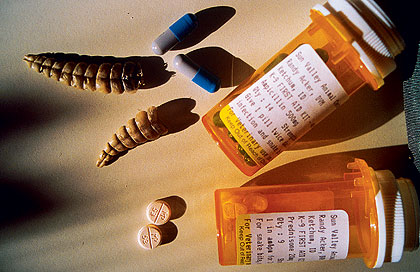 A gun dog bitten by a rattlesnake obviously creates a medical emergency requiring immediate treatment from a veterinarian. But what does a hunting dog owner do if the nearest vet and animal hospital are hours or maybe a day away? With the right veterinarian-prescribed medications, a dog can be successfully treated in the field for this type of catastrophic medical problem. Getting the dog to a vet as soon as possible, however, is still essential. |
Dog First-Aid Kits
"The basic canine first aid kit, whether homemade or commercially manufactured, should always have some bare essentials," states Jim Rieser, a DVM from Franksville, Wisconsin. One obvious category of a kit's requirements is bandages. The "self adherent" type can be used to quickly cover, to partially close up, and to protect minor cuts. Also to be included are gauze-type bandages best for soaking up blood and to cushion lacerations.
Tape is another necessity in any kit, with the medical "adhesive" variety in a one-inch width on a three-foot roll as the most popular choice. A non-adhesive stretch-tape or "vet wrap" should also be included in any canine first aid kit as a way to cover a wide range of needs in medical emergencies.
Less obvious but just as important components in a canine first-aid kit are medical instruments. These should include scissors (blunt tip, stainless steel are best), hemostatic forceps (the surgical-quality stainless steel locking type should be the only kind), and tweezers (again in stainless steel as the only good choice).
Scissors will be used to cut things such as tape when put over bandages or hair between the pads on injured dog feet. Forceps work well to pull out imbedded cactus spines or porcupine quills. And tweezers are essential in picking trash out of open wounds or weed seeds out of dog eyes.
Optional items certainly important in many cases are styptic pencils (to stop bleeding from minor ear cuts or from torn toenails), saline solution (to flush assorted crud out of eyes or to clean bloody wounds), and chlorhexidine ointments (to treat skin rashes or to disinfect lacerations). Rieser also recommends hydrogen peroxide as a good way to clean up a wound and kill germs with the effectiveness, but not the sting, of alcohol.
For those not interested in assembling their own dog first aid kit, there are two relatively simple, inexpensive and useful kits by Outdoor Safety Products (Clint Ronnenburg, www.outdoorsafety.net). The f
irst and most basic is the "Canine First Aid Kit", which comes with the following components: one ounce of sterile eye wash, one half ounce of a triple antibiotic ointment in a squeeze tube, one styptic pencil, two two-inch by five-yard gauze bandages, 10 gauze pads, one two-inch by five-yard self adherent bandage, and a selection of cotton swabs and cotton balls.
Also included are one locking five-inch hemostatic forceps, one five-inch blunt tip stainless steel scissors, one stainless steel thumb forceps (tweezers), and one pair of latex exam gloves.
A short booklet entitled Animal First Aid Guide takes a dog owner through the process of making and applying a muzzle, checking heartbeat and respiration, and taking a dog's temperature. Advice is also given on dealing with cuts, problems with eyes, ears, and noses, leg fractures, drowning, artificial respiration, hypothermia, and porcupine quill removal.
The Canine First Aid Kit itself and the booklet are contained in a zippered Cordura bag measuring a compact six by four by two inches. The price is $29.95; purchasing each item separately would cost more than $45.
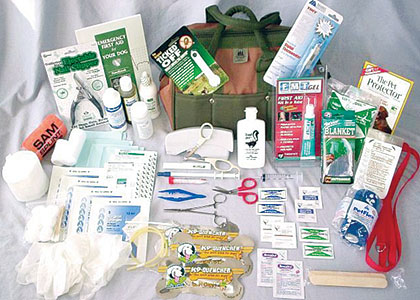 A first aid kit, like this one from Pro Model (3030 kit) is essential when running bird dogs. |
Outdoor Safety's more sophisticated "Premium Kit" has the same components as the simpler "Canine First Aid Kit" but adds to it one instant ice pack, one rectal thermometer in a case, one penlight, and a larger number and selection of bandages. The price is $32.95. Both kits are available directly from Outdoor Safety Products.
Sport Dog First-Aid Kit
New for 2007 at Outdoor Safety Products (DogKits.com) is the Pro Model #3030 Sport Dog First Aid Kit which contains 90 separate items, including a skin stapler; staple remover; EMT Gel; skunk odor remover; tick remover; dog re-hydration drink mix; digital thermometer; nail trimmer; Benadryl; emergency thermal blanket; and a 112-page first aid book.
Also included in the kit are hydrogen peroxide, an instant cold pack, a penlight, a locking hemostat forceps, eye wash, a styptic pencil, surgical pre-scrub, and a pill gun. All of this is in addition to a full supply of bandages, tapes, and pads. The 90 items are contained in a heavy-duty gate-hinged case. Price is $120. Six other models of Canine First Aid Kit are available from Outdoor Safety Products. Which of these books, videos, or kits should the gun dog owner buy? Get them all.
Though each book touches on some of the same subjects, each of the veterinarian-authors presents the material from different perspectives that help the reader to better understand the medical problems described. And each book offers unique insights on some topics not dealt with in the other publication.
The same diversity of perspective and subject matter applies to the two videos with one being complementary to the other. Both of them should be viewed on a regular basis just so a gun dog owner can keep the information and recommended emergency procedures freshly in mind.
Buy the Outdoor Safety "Basic Kit" to carry in the pocket of a hunting jacket or game vest when appropriate. And buy the "Premium Kit" to carry in your vehicle, keep at your hunting shack, or to put in your field bag.
Keep the books (which will fit in a coat pocket) close to the kits (which are portable) so you will always be ready to handle most minor hunting dog crises and many major catastrophes encountered in the field.
"By the end of next week you can hunt her," the vet told my hunting partner after putting three stitches into his Labrador's cut front leg. "You did a good job of cleaning the wound and putting on bandages in the field," he added.
Only the best first aid procedures and equipment should be good enough for our gun dogs. My guess is, you already knew this.






